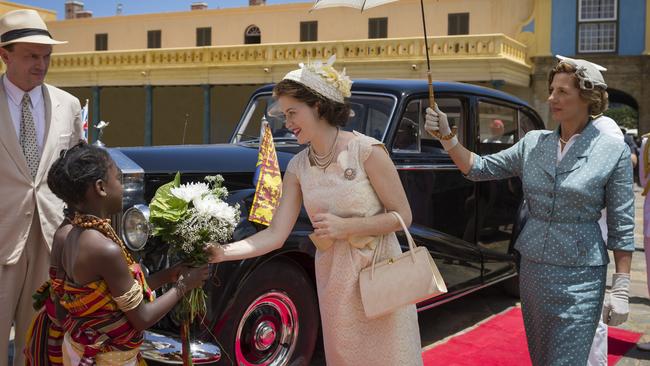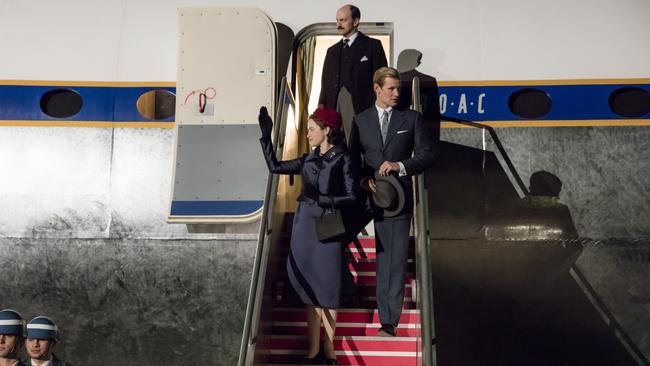The Crown, season two: still royally absorbing
The second season of The Crown maintains its superb standards as it enters darker territory.

‘I don’t know that the golden age of television is really television as we know it,” says director David Fincher, who really launched the age of Netflix with his original series House of Cards in 2013. “It’s something that’s grown out of certain expectations, blurring and subverting a lot of those expectations in surprising ways.”
Peter Morgan, creator of The Crown, calls it quite simply “cinematic television”, and there have been few shows with its production values. It cost a substantial $US6 million ($7.9m) to $US7m an episode for 20 episodes — or about $US130m — with Netflix paying in advance for two seasons, as well as bonuses to buy out all future royalties.
Morgan recently said of this new TV that it possessed “the attention and the bespokeness” of the feature film, but industrialised for a TV production line, new levels of quality expected but on old timetables.
Season two of The Crown is with us this Friday, and more than 12 months later it’s hard to recall just how the first season ended. Such was the kaleidoscopic effect of the many characters and ideas Morgan and his group of creative collaborators, including executive producer and director Stephen Daldry, presented. So many of us rarely put down the remote as we gorged ourselves on this sumptuous series.
What of the Queen, played with such control by Claire Foy, and her travails? Well, the plot involving Princess Margaret (Vanessa Kirby) and group captain Peter Townsend (Ben Miles) and their tumultuous love affair was brought to an unhappy ending in a devastating scene when the Queen told her sister she would not honour her promise to allow her to marry him, given the extreme hostility from church and parliament. Troublesome Townsend was packed off to Brussels; Margaret hotted it up on the London party circuit.
The Suez crisis began to escalate, with prime minister Anthony Eden (Jeremy Northam) obviously out of his depth, nursing some kind of addiction, and the Queen’s marriage appeared somewhat shaky as well. An angry Philip (the charismatic Matt Smith), still reluctant to walk in her shadow, was banished to Australia for the Olympics, resentful and frustrated. “Don’t dress betrayal up as a favour,” he snapped, saying it was “like being shipped off to a penal colony”.
Things were falling apart, and it was obvious that the charmingly shy young woman we met at the start of the series — that “living, breathing thing”, according to her husband — was uneasy in the role of Elizabeth Regina. At the end the succession seemed complete, as she posed for her official portrait, in the name of duty quietly suppressing individuality, ready to take on that facade of royal impassivity we would come to know so well.
At the start of the new season, it is five months later — February 16, 1957 — and with the royal yacht in Lisbon’s Setubal Harbour, Elizabeth and Philip are reunited after a four-month separation. The long period apart has set off international conjecture about their marital status. After speaking with her press secretary by phone, telling him to address the many rumours — there are photographers stalking the ship and a radio newscast full of dire suggestions — she turns to a sulking Philip and demands they “lay their cards on the table” and “talk frankly for once about what needs to change to make this marriage work”.
He calls it a stupid question, then asks, “Well, who goes first? If I’ve learned one thing it’s I go second.” It’s a superb scene to open with — edgy, intimate, Elizabeth exhausted, Philip restless. She repudiates his “whingeing and whining like a child”, and tells him: “I’ve learned more about humiliation in a week than I have in a lifetime”, that he is lost in his role and lost in his self, and that divorce is not an option. “You’re asking my price?” he asks. “I’m asking what it will take.”

We cut back in time and it’s five months earlier. Philip is about to leave for the Olympics and a long Commonwealth tour. They are flirty, mischievous and intimate with each other, sexually playful even in front of their servants. She even invites him into the royal bed so he can practise his callisthenics on her. “She and I are getting along rather nicely at the moment,” he later tells his affable Australian equerry, Mike Parker (Daniel Ings), as they drive off to the bibulous weekly stag meetings of the Lunch Club. But international events interrupt the pleasantness of life before he leaves and the sun begins to sink further over the British Empire.
Egypt’s colonel Gamal Abdel Nasser (Amir Boutrous) abruptly announces the nationalisation of the Suez Canal and his soldiers occupy its headquarters. Eden, a master of self-delusion, is scandalised, but the Queen is more perturbed when she discovers a photo of a ballerina in her husband’s briefcase the night before he flies out with Parker. She is distant in her discussions about the crisis with a bellicose Eden, obviously shocked by her discovery. When Philip leaves, he does so with a note in that briefcase: “Always remember you have a family.”
Eden readies for his imperial adventure, a play for legacy. The British and French are in secret negotiations with Israel to forge an agreement for joint military operations. Israeli forces take the Sinai Peninsula and the Anglo-French invasion is soon under way.
Elizabeth hears nothing from Philip, and in a simply superb sequence goes to the ballet to watch the dancer, her face showing shame, fear and loneliness. She becomes more lost, even her prayers at bedtime brief and perfunctory, a simple pause and then “amen”.
It’s glorious storytelling, highly nuanced and elegant, and such an absorbing narrative of rectitude, loyalty, difficult love and self-sacrifice. The season should provide the cliffhangers and set pieces we love in this series, as the naked prejudice of the imperial era bubbles to the surface over Suez, further light is shone on the complexity of Philip and his possible infidelities, Margaret finds her new love, photographer Antony Armstrong-Jones, and Elizabeth somehow discovers that stoicism, her sense of duty and her staying power.
The inspiration for the show’s cinematic density came at the first meeting between production designer Martin Childs and Daldry. “It was this digital picture I made using Photoshop of a postwar, almost apocalyptic level of austerity, with buildings crumbling, and through a doorway you could see a fabulous wealth of richness,” Childs told Indiewire. “It would be the image we would keep going to back to as the visual motif.”
The idea, according to Childs, was to accentuate the vast scale of royal life and convey a sense of its emptiness. “It’s a gilded cage in lots of ways, so you want to always get this sense of a huge, unfriendly place that they are rattling around in,” said Daldry, who directs several episodes in the new season.
They also employed a kind of rooms-within-rooms concept, the castles where the royals live usually devoid of corridors, which were widely used architecturally only since the 19th century. Before their adoption, movement was from one room to the next, forcing interactions and confrontations between occupants and those just passing through. The show’s design sense comes from sets that allow us to peer into multiple rooms at the same time, sometimes in stationary wide shots and more often with moving cameras on cranes, creating what Childs calls “this almost infinite perspective of doorways”.
In the interview, they reveal that this sense of frames-within-frames also became a key storytelling device for Daldry and Childs. In particular, it conveyed the detachment and remoteness that developed between the young Queen and her family members — especially her husband, who has so much trouble adjusting to his new bride in a position of such power.
It’s a distinctive visual aesthetic, on a scale that has never been attempted at this level before. Nor have we seen cameras used in this highly cinematic way, with movements that must have taken many hours to light. (Interestingly, in this first new episode so much of the light blasts in from outside, the interiors burnished and often gloomy — it’s as if the world is moving fast outside while the lives of the people within remain largely static.)
One thing is certain: those cameras will take us through many doorways into many interesting rooms as we move into the 60s and that decade has its disruptive way with royalty.
The Crown, streaming on Netflix from Friday.




To join the conversation, please log in. Don't have an account? Register
Join the conversation, you are commenting as Logout